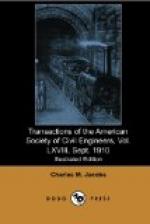WASH-BORINGS.
The general plan of enclosing the area in retaining walls having been adopted, wash-borings were taken, for the purpose of determining the best location for the walls, the depth of rock, and the nature of the material overlying it. These borings were made along both curb lines of Seventh Avenue, the east curb line of Ninth Avenue, the north curb line of 33d Street, and the south curb line of 31st Street. The borings, as a rule, were taken at intervals of approximately 100 ft., some deviation in these intervals being made in order to prevent injury to water, gas, and sewer connections, and, if the elevation of the surface of the rock, as determined by one of these borings, corresponded fairly well with the borings on either side of it, no intermediate borings were taken. When a discrepancy appeared, a boring was taken midway between the two non-corresponding ones, and if the information obtained from the intermediate boring failed to account for the discrepancy, others were taken at the quarter points of the original 100-ft. interval.
The dotted lines on Fig. 1 show the profiles of the surface of the rock underlying 31st and 33d Streets, on the line of the borings, constructed from the elevations obtained by them; the solid lines show the profiles of the actual surface of the rock as found when uncovered. It will be noted that, except in three cases, Borings 313, 328, and 333, the two profiles correspond very closely at the points where the borings were made, but they differ widely between those points, a variation of 5 ft. being common; there is a variation of 14 ft. between Borings 324 and 327, and between Nos. 337 and 340; and of 12 ft. between Nos. 333 and 335, and between Nos. 312 and 313, while an extreme variation of 17 ft. is shown between Nos. 303 and 305. At each of the points where the variation is great the interval between borings is the full 100 ft., and it is quite apparent that, if a definite idea is to be obtained of the elevation of the surface of the rock in Manhattan, borings must be taken at shorter intervals.
The necessary width of trench for the construction of the retaining walls was determined by the elevation of the rock, as shown by the borings, and only in the case of the dip between Borings 303 and 305 did the variation lead to any difficulty. The trench at that point had to be widened after rock was reached. This depression corresponded very closely in location to that of one arm of the creek shown on General Viele’s map of 1865,[2] the bed of that stream, or one in approximately the same location, being clearly marked across the excavation by smoothly-worn rock and well-rounded boulders. The original stream, however, seemed to have turned in a westerly direction under 31st Street to Eighth Avenue instead of crossing, as shown on General Viele’s map.
[Illustration: Fig. 1. Profile of rock surfaces in thirty-first and thirty-third streets, between seventh and ninth avenues]




